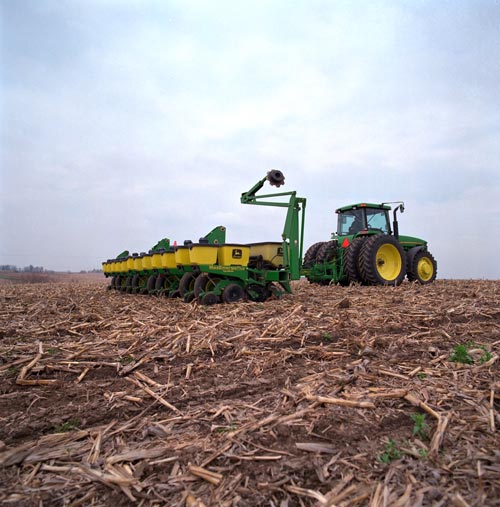
Depreciation is a valuable tool for farmers and ranchers to use in limiting tax liabilities, but they should be cautious about over-using some options and also should determine the most advantageous time to take advantage of certain opportunities.
“Producers need to remember how important a tool depreciation can be and take advantage of opportunities in the tax code,” says Robert Gunther, CPA with Frost PLLC.
Gunther, along with Roger McEowen, professor of agricultural law and taxation at Iowa State University, discussed how changes in depreciation rules will affect farmers and ranchers during a recent webinar. The webinar was sponsored by TractorLife.com.
Gunther and McEowen said producers need to be aware of recent depreciation rules changes as they consider late-year investments.
“Consider when to place items in service,” said Gunther. “That can affect tax benefits.”
They discussed new developments in depreciation brought about by the Small Business Jobs Act of 2010 as well as changes in Bonus Depreciation made by the 12/17/10 Act. Specifically, that legislation increased Section 179 expensing and increased Bonus Depreciation. Section 179 expensing “generally allows a 100 percent write-off of qualifying asset costs (with limitations)." Section 179 is available for new or used property.
Limits will change. For 2011, the Section 179 expensing limit is $500,000 with a phase-out threshold of $2 million. In 2012, those limits change to $125,000 and a $500,000 threshold. In 2013 the limit drops to $25,000 with a threshold of $200,000.
McEowen said some changes may be extended as Congress takes up individual parts of the jobs bill.
Bonus Depreciation is available to any size taxpayer but conformity varies from state to state. Bonus Depreciation generally allows a 50 percent to 100 percent write-off of a fixed asset cost in the year the asset is placed in service. Bonus Depreciation applies to new assets only.
Pending changes include a reduction from 100 percent Bonus Depreciation in 2011 to 50 percent in 2012.
McEowen says qualifying property for Section 179 includes tangible personal property,structures that store fungible commodities, single-purpose agricultural structures, off-the-shelf software (through 2013) and qualified real property (for 2010 and 2011).
“Property must be placed in service during the tax year,” McEowen said. He said producers can “make or revoke an expense method depreciation on an amended return for ‘open’ tax years. That’s good through 2012. That’s a good tool if you make a mistake or change tax strategy.”
Not all property is eligible for Section 179 depreciation. The unqualified list includes: air conditioning and heating units; property owned by estates and trusts; property acquired from a related party; carryover part of basis attributable to traded property; property not used in the taxpayer’s trade or business at time acquired; and property used less than 50 percent in a taxpayer’s trade or business.
McEowen said using a farm building for a non-farm business could disqualify the property for Section 179 depreciation.
Bonus Depreciation
Bonus Depreciation rate for 2010 is 50 percent. The Tax Act that runs through 2011 provides 100 percent depreciation for qualified assets acquired and placed in service after 9/8/10. The depreciation rate for qualified assets acquired before 9/9/10 and placed into service after 9/8/10 is 50 percent.
“The only elective option for post 9/8/10 acquisitions is the regular Modified Accelerated Cost Recovery System (MACRS),” McEowen said.
New property with a recovery period of 20 years or less is eligible for Bonus Depreciation.
Gunther illustrated differences between Section 179 and Bonus Depreciation:
For Section 179, new or used equipment applies; for Bonus Depreciation, only new equipment is allowed.
Section 179 is available to small to mid-sized companies; Bonus Depreciation is available to all companies.
Varying state conformity is the case for both 179 and Bonus Depreciation.
Section 179 can only offset income while Bonus Depreciation may create losses.
Gunther offered examples. A tractor costing $200,000 put in service on 11/15/2011 offers a potential 2011 tax deduction of $200,000 for both Section 179 and Bonus Depreciation. With a taxable income before purchase of $150,000, the taxable income or loss after purchase would be nothing for Section 179 and a $50,000 loss with Bonus Depreciation.
If that same tractor is put in service on 1/15/2012, under Section 179 (assuming taxable income before purchase is $200,000), potential tax deduction is $133,036 with a taxable income after purchase of $66,964. With Bonus Depreciation on the tractor put in service on 1/15/2012 (assuming taxable income before purchase is $200,000), potential tax deduction is $110,714 and taxable income after purchase is $89,286.
A significant difference exists in tax exposure between 2011 and 2012 and between Section 179 and Bonus Depreciation in 2012.
McEowen says farmers and their tax advisers should evaluate available depreciation opportunities to determine the best options. He recommends Section 179 for assets with the longest lives and on all equipment. “Use Bonus Depreciation on all qualified purchases and regular depreciation on remaining assets.”
About the Author(s)
You May Also Like






